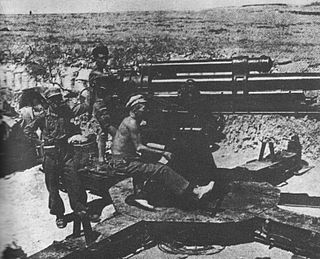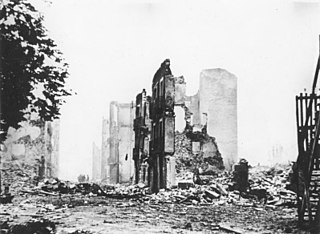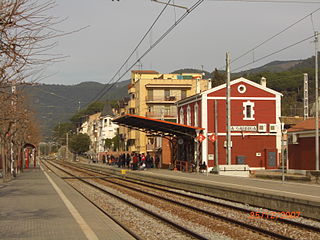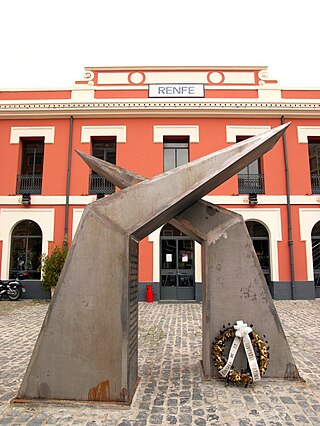
The Royal Italian Air Force (RAI) was the name of the air force of the Kingdom of Italy. It was established as a service independent of the Royal Italian Army from 1923 until 1946. In 1946, the monarchy was abolished and the Kingdom of Italy became the Italian Republic, whereupon the name of the air force changed to Aeronautica Militare.

The Condor Legion was a unit of military personnel from the air force and army of Nazi Germany’s Wehrmacht which served with the Nationalist faction during the Spanish Civil War. The Condor Legion developed methods of strategic bombing that were used widely during the Second World War. The bombing of Guernica was the most infamous operation by the Condor Legion. Hugo Sperrle commanded the unit's aircraft formations and Wilhelm Ritter von Thoma commanded the ground element.

The Battle of Guadalajara saw the victory of the Spanish Republican Army and of the International Brigades over the Italian and Nationalist forces attempting to encircle Madrid during the Spanish Civil War. The Nationalist forces involved in the Battle of Guadalajara were primarily the Italian Corps of Volunteer Troops.

The Battle of the Ebro was the longest and largest battle of the Spanish Civil War and the greatest, in terms of manpower, logistics and material ever fought on Spanish soil. It took place between July and November 1938, with fighting mainly concentrated in two areas on the lower course of the Ebro River, the Terra Alta comarca of Catalonia, and the Auts area close to Fayón (Faió) in the lower Matarranya, Eastern Lower Aragon. These sparsely populated areas saw the largest array of armies in the war. The battle was disastrous for the Second Spanish Republic, with tens of thousands left dead or wounded and little effect on the advance of the Nationalists.

On 26 April 1937, the Basque town of Guernica was aerially bombed during the Spanish Civil War. It was carried out at the behest of Francisco Franco's rebel Nationalist faction by its allies, the Nazi German Luftwaffe's Condor Legion and the Fascist Italian Aviazione Legionaria, under the code name Operation Rügen. The town was being used as a communications centre by Republican forces just behind the front line, and the raid was intended to destroy bridges and roads. The operation opened the way to Franco's capture of Bilbao and his victory in northern Spain.

The Fiat BR.20 Cicogna was a low-wing twin-engine medium bomber that was developed and manufactured by Italian aircraft company Fiat. It holds the distinction of being the first all-metal Italian bomber to enter service; at the time, it was regarded as one of the most modern medium bombers in the world.

The Spanish Air and Space Force (SASF) is the aerial and space warfare branch of the Spanish Armed Forces.

The Battle of Cape Cherchell was a naval battle between the Nationalist heavy cruiser Baleares and the Spanish Republican Navy light cruisers Libertad and Méndez Núñez in the Spanish Civil War, several miles north of the Algerian city of Cherchell. In the early morning hours of 7 September 1937, Baleares unexpectedly met a Republican convoy consisting of two merchant ships escorted by Republican cruisers and destroyers. Baleares was beaten off and badly damaged in the engagement, but the merchantmen were lost when they tried to slip away along the Algerine shoreline.

The Legionary Air Force was an expeditionary corps from the Italian Royal Air Force that was set up in 1936. It was sent to provide logistical and tactical support to the Nationalist faction after the Spanish coup of July 1936, which marked the onset of the Spanish Civil War.

The Spanish Republican Air Force was the air arm of the Armed Forces of the Second Spanish Republic, the legally established government of Spain between 1931 and 1939. Initially divided into two branches: Military Aeronautics and Naval Aeronautics, the Republican Air Force became the Air Forces of the Spanish Republic, also known as Arma de Aviación, after it was reorganized following the restructuring of the Republican Armed Forces in September 1936, at the beginning of the Spanish Civil War. This defunct Air Force is largely known for the intense action it saw during the Civil War, from July 1936 till its disbandment in 1939.

The Savoia-Marchetti SM.81 first saw combat during the Second Italo-Abyssinian War, where it showed itself to be versatile, serving as a bomber, transport and reconnaissance aircraft. SM.81s also fought in the Spanish Civil War with the Aviazione Legionaria and were among the first aircraft sent by the fascist powers to aid Francisco Franco.

The Biscay Campaign was an offensive of the Spanish Civil War which lasted from 31 March to 1 July 1937. 50,000 men of the Eusko Gudarostea met 65,000 men of the insurgent forces. After heavy combats the Nationalist forces with a crushing material superiority managed to occupy the city of Bilbao and the Biscay province.

The Bombing of Durango took place on 31 March 1937, during the Spanish Civil War. On 31 March 1937 the Nationalists started their offensive against the Republican held province of Biscay. As part of the offensive the Aviazione Legionaria and the Legion Condor bombed Durango, a town of 10,000 inhabitants that was also a key road and railway junction behind the frontline. Around 250 people are believed to have died in the bombing.
The bombing of Cabra was a aerial bombing raid on the town of Cabra, Andalusia during the Spanish Civil War. The air raid carried out by the Republican faction killed 109 civilians and wounded more than 200.

The Bombing of Barcelona was a series of airstrikes led by Fascist Italy and Nazi Germany supporting the Franco-led Nationalist rebel army, which took place from 16 to 18 March 1938, during the Spanish Civil War. Up to 1,300 people were killed and at least 2,000 were wounded.

The Bombing of Granollers took place during the Spanish Civil War in 1938. On 31 May 1938, the Italian Aviazione Legionaria bombed the town of Granollers. There were between 100 and 224 civilian deaths.

The Bombing of La Garriga were a series of Nationalist air raids which took place at La Garriga, Barcelona province in Catalonia between 28 and 29 January 1939 during the Spanish Civil War. At least 13 civilians were killed in the bombings.

The Bombing of Xàtiva was an aerial bombing of the railway station of Xàtiva, Valencia Province, during the last phase of the Spanish Civil War. It was carried out on 12 February 1939 at the behest of Francisco Franco's nationalist government by the Aviazione Legionaria of its Fascist Italian allies.

The bombing of Sant Vicenç de Calders was an aerial bombing of the railway station of Sant Vicenç de Calders, Catalonia, during the Spanish Civil War. It was carried out on 8 October 1938 at the behest of Francisco Franco's nationalist regime by the Aviazione Legionaria of its fascist Italian allies.

The Italian military intervention in Spain took place during the Spanish Civil War in order to support the nationalist cause against the Second Spanish Republic. As the conquest of Ethiopia in the Second Italo-Ethiopian War made Italy confident in its power, Benito Mussolini joined the war to expand the Fascist sphere of influence in the Mediterranean. Italy supplied machine guns, artillery, aircraft, tankettes, the Aviazione Legionaria, and the Corpo Truppe Volontarie (CTV) to the Nationalist cause. The Royal Italian Navy played a substantial role in the conflict and Italian warships took part in breaking the Republican navy's blockade of Nationalist-held Spanish Morocco and took part in naval bombardment of Republican-held Málaga, Valencia, and Barcelona.



















